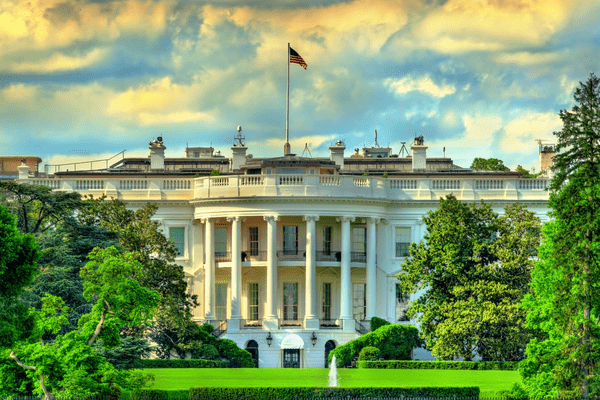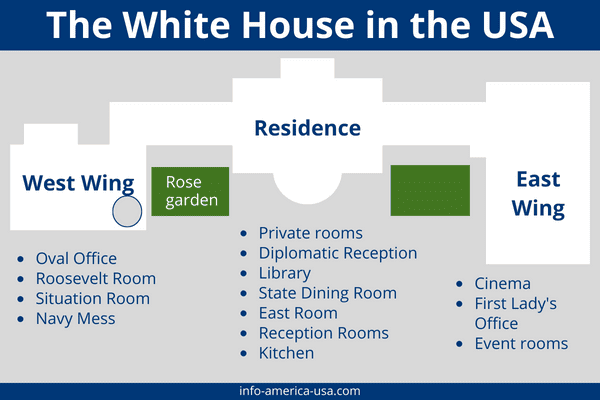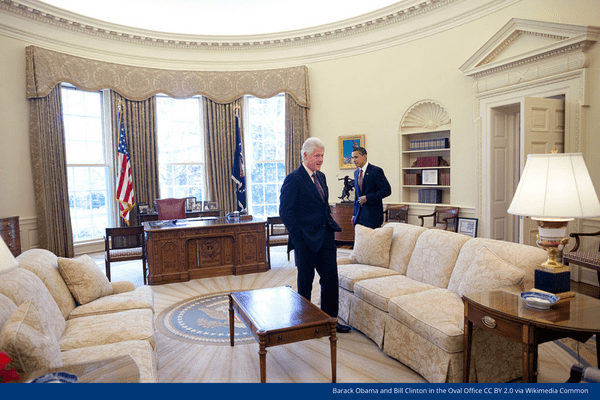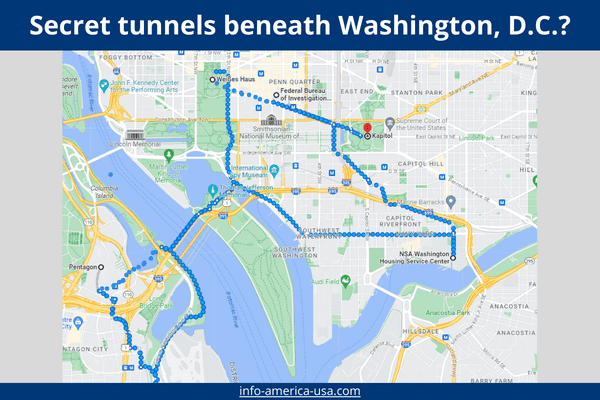

Have you ever wondered what goes on behind the walls of the White House in Washington, D.C.? We'll take you inside the official home and workplace of the President of the United States and reveal some well-kept secrets about the White House.
The White House in Washington, D.C., is the official residence and workplace of the President of the United States of America. A symbol of US democracy, it welcomes government officials and guests of state every day and is one of the most popular tourist attractions in the United States.

Approximately 90 employees manage and maintain the White House. As a result, the neoclassical building is still in excellent condition despite being over 200 years old.
Millions of people visit the White House annually for various reasons, but few know its inner workings. Not only does the building consist of public state rooms and the private living quarters of the US President and the "First Family," it also holds a few secrets.
Here are some quick facts about the White House in Washington, D.C.:
The White House consists of a main living area (Executive Residence or Villa), the East Wing, and the West Wing.

The Main House of the White House (also known as the "White House Residence," "The Residence," or "Executive Residence") contains the living quarters of the President and his family. There are also event and reception rooms, a library, a kitchen, and the main dining room.
The largest room in the Executive Residence is used for various events, including press conferences, receptions, balls, and large state dinners.
Located on the upper floor, these reception rooms are often used for small receptions, meetings, and ceremonies.
This is the formal dining room of the White House and is often used for state dinners and other formal events. A smaller dining room for the President's family is also located in the building.
The China Room is located on the ground floor of the Main House, just off the entrance hall. It is named for the collection of Chinese porcelain used for formal occasions and state dinners.
The East Wing of the White House was added in 1942. If you are a visitor to the Presidential residence, this is your guest entrance.
There are numerous rooms and offices on the two floors of the East Wing, but not many of them are fully known as to their function. Only the First Lady's official office, the First Lady's staff rooms, and the movie theater have permanent standing on the public floor plans.
Right next to the world-famous colonnade overlooking the garden is the long White House movie theater, which the President sometimes uses to rehearse his speeches.
The Presidential Emergency Operations Center (PEOC) is the bunker under the East Wing of the White House. It is designed to serve as a pullback for the President in the event of danger.
The President and his staff have their offices in the West Wing. Although only two floors are visible from the front, a third, enormously important floor is hidden in the basement of the West Wing: the "Ground Floor" with the Situation Room.
The Situation Room, or John F. Kennedy Conference Room, is operated by the National Security Council staff and is used to monitor global crisis situations and communicate with foreign countries.
This high-security room is equipped with the most advanced communications systems in the world. It is from here that the President commands the armed forces deployed around the world.
In the southeast corner of the West Wing of the White House is the Oval Office. Named for its oval shape, it has been used by the President of the United States as his primary workspace since 1909.
Meetings with world leaders are held in this most famous office in the world. It is also where the President signs important legislation and delivers televised addresses to the nation.

The Oval Office is decorated with antique furniture and artwork. A unique feature is the "Resolute Desk," made from the HMS Resolute ship’s wood. Other notable features include a fireplace, several sofas and armchairs, and several bookshelves filled with important literary and historical texts.
The White House is a highly secure facility. Access to many areas is restricted to authorized personnel to ensure the safety of the President, his family, and his staff. That's why few people know how many secret passageways and escape doors there are in the White House. One of them, however, is regularly mentioned in connection with the Oval Office.
According to official information from the White House Historical Association, there are only a few entrances to safe rooms under the White House. However, the exact number and location are classified for security reasons.
One of the entrances is said to be through the North Lawn of the White House, where a seemingly ordinary protective wall hides it. Another entrance is said to be on nearby Executive Avenue.
News agencies have reported that at least two Presidents have used the bunker under the White House: President George W. Bush during the 9/11 terrorist attacks and Donald Trump, who is said to have hid there during the storming of the Capitol on January 6th, 2020.
Maps have circulated on the Internet showing secret passageways leading from the White House to other key locations in Washington, D.C., such as the Pentagon or the Capitol.
While the existence of these secret passageways makes sense, there are, of course, no official maps, as such security information should be classified. The maps circulating on the Internet are, therefore, half-truths at best.

Wherever the President goes within the White House, he is accompanied by security personnel. There are also bulletproof glass windows and alarm buttons in many places. If you ever want to tour the White House, you will have to go through an extensive security check.
The site for the White House was selected in 1791 by the first President of the United States, George Washington. The cornerstone was laid the following year, and construction, designed by Irish-born architect James Hoban, began.
The new government building was constructed of Aquia Creek sandstone quarried 45 miles away. It took eight years to build and cost $ 232,371 (about $ 3.35 million in today's purchasing power).
President John Adams and his wife, Abigail, moved into the unfinished house. At this time, the White House was still known as the "President's Mansion" or "President's Castle.”
During the War of 1812, the British set fire to the White House. Architect James Hoban was again commissioned to rebuild the President's House. In 1902, President Theodore Roosevelt finally began a significant renovation, including moving the offices from the Main Building to the newly constructed West Wing.
The famous Oval Office in the West Wing was not built until 1909 by Roosevelt's successor, William Howard Taft. The egg-shaped office was initially placed in the center of the West Wing by architect Nathan C. Wyeth to serve as the headquarters for all offices.
However, 20 years later, the Oval Office was destroyed by fire, leaving room for a redesign. At first, there was only a new room concept, but the office stayed where it was. Then, in 1934, the Oval Office was moved to the southeast corner of the West Wing.
Less than fifty years after the Roosevelt renovation, the White House showed signs of deterioration, so President Harry S. Truman began the renovation process again. The interior structure was replaced, and the building was reinforced with steel beams. Since then, the White House has been renovated and modernized several times.
Every President since John Adams has lived in the White House. It has been the site of many important events in American history. For example, President Abraham Lincoln delivered his famous Gettysburg Address from the White House, and it was also the place where he was assassinated in 1865.
In 1933, President Franklin D. Roosevelt delivered his inaugural address from the White House, declaring: "The only thing we have to fear is fear itself.” In 1963, President John F. Kennedy was assassinated in Dallas, and his body was brought to the White House for a public ceremony.
In recent years, the White House has faced many challenges, including security breaches and protests on its grounds. However, these incidents have not diminished its importance as a symbol of the presidency. The White House remains a testament to the strength and resilience of American democracy.
You probably don't know these exciting facts about the White House:
To book a tour of the White House, you must first apply to your US Embassy, which can take a few weeks. We, therefore, recommend that you plan early.
All tours of the White House are free. However, your already reserved tour may be canceled at the last minute due to unforeseen events disrupting the official White House schedule.
Feel free to contact the White House Visitor Center.
Given the upcoming US elections in November 2024, the White House will be exceptionally busy. During the preparations for the election, the President is active on several fronts. His daily work includes press conferences, issuing orders, and appearing at public events.
The President's staff must research and analyze political issues, compose speeches, follow international news, and coordinate with other federal officials. They must also ensure that the President's views are reflected in the election campaign.
However, the protocol for White House elections is pretty standard. The President and Vice President must remain neutral in their public statements and comply with the laws and regulations of the electoral process. In addition, White House staff must respect the candidates and the election process and ensure that the election is fair and without interference.
Once the election is decided, the White House staff prepares to transition to a new administration. This includes organizing the transition team, preparing the budget for the new administration, and drilling the White House for the inauguration.
In recent years, US elections have been more exciting and polarizing than ever before. This is primarily due to two factors: changes in US political currents and developments in American society.
Regarding political currents, the USA has seen a growing divide between the two major political parties. On the one hand, the Republican Party has become increasingly conservative and focuses on measures such as tax cuts and deregulation.
On the other hand, the Democratic Party has become more progressive, focusing on social issues such as health care and civil rights. This has led to the two parties becoming increasingly ideologically distinct.
If you are not in the United States, the best way to follow the US elections is through online channels and international news sources. Before the election, you can learn about the candidates' platforms, backgrounds, and issues. It's also a good idea to follow the election map on CNN, which is constantly updated.
What: CC BY 2.0 via Wikimedia Commons - Barack Obama and Bill Clinton in the Oval Office CC BY 2.0 via Wikimedia Commons
With an ESTA, you can stay 90 days visa-free in the USA. Apply online now!